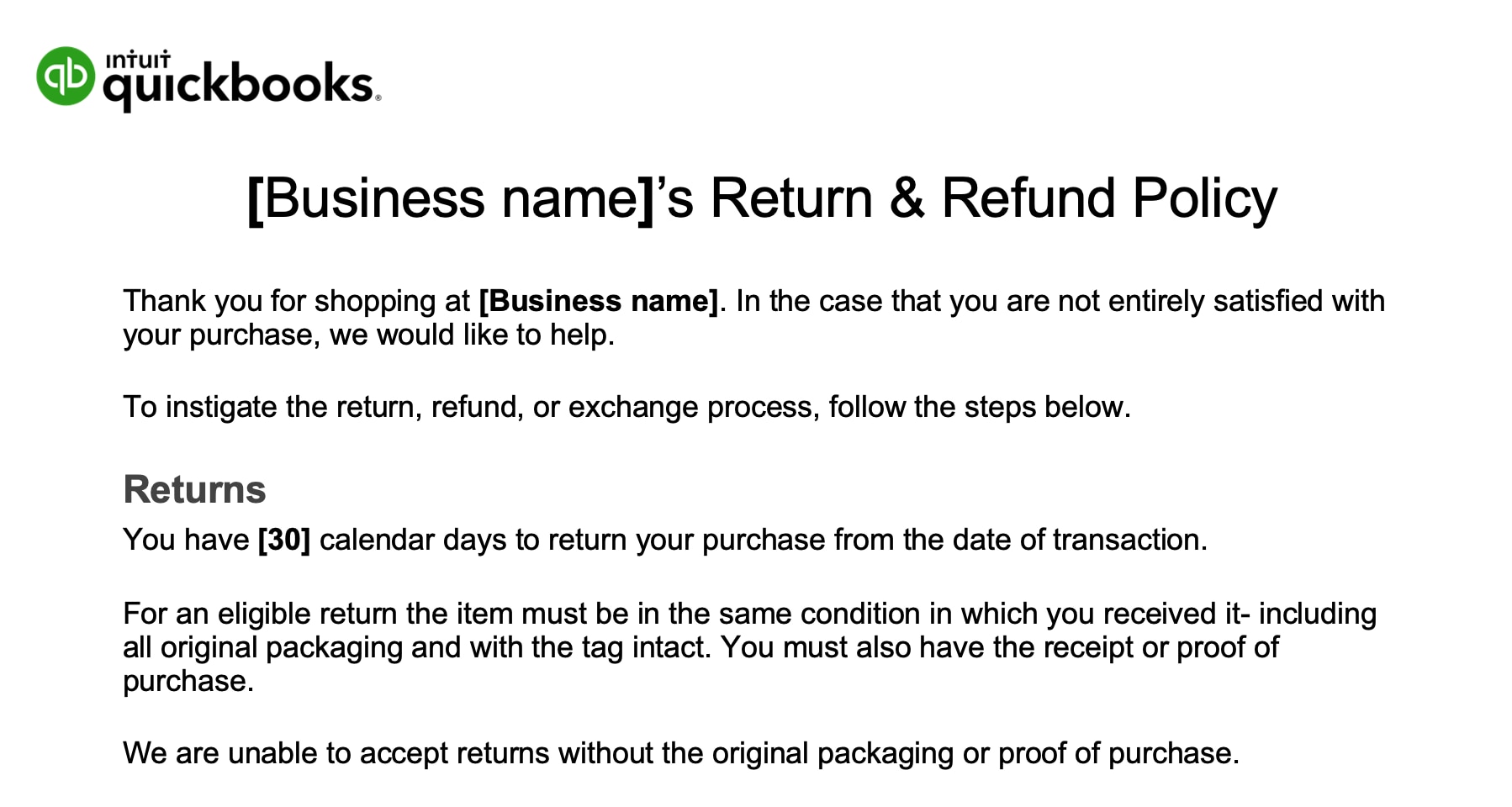Taking the time to come up with a thoughtful return policy that is tailored to your target market’s needs is vital to your customer satisfaction. You want to make sure your return policy is covering all the bases to protect your small business from any unexpected mishaps that may occur.

How to Write a Return Policy for Small Businesses
What is a Return Policy?
Return and exchange policies are rules established by a small business to handle the process of how customers return or exchange unwanted goods. It’s an arrangement between the buyer and seller to determine what options are available and what steps need to be taken if the buyer is not satisfied with their purchase.
Here are the four main options if a buyer is not satisfied with their purchase:
- Offer an exchange policy: They could do an exchange with something of equal value or greater value. If it’s the former then the customer would need to pay for the difference.
- Provide a full refund to the customer: Or refund a portion of their money if they want to do an exchange with an item that has less value than the original.
- Offer a return for store credit: Provide the customer with a store credit of equal value to their original purchase.
- Final sale: No returns, refunds, or exchanges are allowed.
If the customer simply changes their mind, there is no refund policy in Canadian or Ontario law that requires you to give customers their money back.
Why Do Companies Have Refund Policies?
Like all policies, a return and refund policy keeps your business running smoothly. Return policies may seem like an unnecessary headache but they are a crucial part of building customer loyalty.
When customers return an item they bought, managers generally look at this as a loss, but they are not necessarily right to. A customer-centric return policy will give the customer peace of mind.
For example, if a customer is hesitant about a purchase, if they have no option of returning it, they will more likely just not take the risk and leave the item on the shelf. Whereas if the customer was hesitant about a product, but the store did offer a refund policy, the customer will be more likely to take the risk and purchase the item.
A liberal return policy has been proven to boost sales for this reason. Since it is especially important for small businesses to have excellent customer care, a liberal return policy is recommended.
Return Policies for E-Commerce
One way to stay competitive in an online retail environment is through a good return policy. As an online store, it’s especially important to offer a return policy, since your customers can’t physically see or touch the items they are purchasing. A tool that will help eCommerce stores with this process is a return merchandising system (RMA). An RMA is for businesses that do not sell their merchandise in a brick-and-mortar store.
Using an RMA system will make your returns run efficiently. It helps you manage and track your returns by relisting approved items back into your inventory and monitoring the financial impact of returns on your bottom line. This system also makes it quick and simple for customers to send items back.
Best Practices for an RMA System:
Not all small businesses are made equal, so not all return policies will be the same. There are, however, a few best practices when using the RMA system.
1. Initiate the return online
The RMA system will make it easier for customers to initiate their return online instead of having to call an agent and wait on hold over the phone
2. When a customer initiates a refund, give them the option to exchange
If a customer is opting for a refund, give them a chance to pick a replacement product. Sometimes shipping errors occur and the customer receives the wrong item. The RMA system will make it easy for the customer to exchange the item they got with their original choice
3. Allow the customers to print return labels
Whether it be returns, refunds, and exchanges, your customer will need to ship the item back to you. It is your responsibility to ensure the process is as painless as possible. One way to do that is by setting up your RMA system to send shipping labels by email, so your customers can easily print them out.
A policy that covers shipping costs gives your consumers excellent customer service, and they will be more likely to use your site to shop. Therefore, it is important to state whether or not your business will cover the cost of return shipping.
4. Make the return easy to monitor
Linking returns to their original orders also makes them easier to monitor. Your RMA system should let you check on the progress of returns in a matter of seconds. You should know if a returning product is in transit or has arrived at your warehouse. You must also monitor how and when refunds get actioned, or exchange items dispatched.
What to Include in Your Return and Refund Policy
The information on your standard return policy needs to give the buyer clear outlines for what will and will not be accepted. That way they avoid any unexpected surprises and an unhappy customer should they. Therefore, such business policies should include the following things to make returns and refunds as painless as possible.
1. What products can be returned
You need to include what kind of merchandise can be returned, refunded, or exchanged, and what items you will not be taking back. For example, many businesses will not accept product returns on sale items, or other discounted products. Therefore, such specifications must be stated in the return policy.
2. The time frame for returns
The time frame that you give people to make returns, refunds, or exchanges needs to be clear. Maybe you have a different time frame to return merchandise then you do for exchanging products. Suppose you only give 30 days for returns but you give 90 days for store credit and exchanges. These details need to be written in the policy.
3. The condition of the product
The condition of the item that you will accept needs to be clearly stated on the return policy. Generally, well-written policies state that to handle returns and accept exchanges, the product must be in the same condition it was originally purchased. This means all original wrapping and tags must be intact.
It is important to note in the policy that if a seal is broken or the product is not in its original packaging, your business is not obligated to process a return, exchange, or refund.
4. Proof of purchase
Receipts always need to be given at the point of purchase whether it be an email or printed. The customer needs to have proof of purchase for their records, as well as your business records. For that reason, almost all policies will state that a receipt is required to process a return or exchange.
5. Situations for allowable returns
The acceptable reasons for exchange should be on the return policy. This is where businesses decide how lenient or strict they would like to be about returns. For example, allowing customers to return items just because they don’t like the look of something anymore. However, you could choose to say that the only acceptable reason for return is if there is a defect on the item.
6. How to initiate the return
The return policy should let the customer know how to start the return process. This could be different for online and in-person stores. Usually, in-person stores are straightforward. Online stores will have more steps when processing returns, like printing shipping labels, covering shipping charges, and waiting however many days to get fully refunded etc.
Whatever that process is, make sure your return policy spells it out for the customer to make it as smooth a transaction as possible.
Return Policy Template
If you need some help to create a return policy, consider downloading and using this free template. It outlines the basics of what should be included in a return and refund policy. Just fill in each section with your specific information.
Where To Post Your Policy
The return policy should be stated on the back and or front of the receipt. This way the customer can have a copy of it on hand if needed. The policy should also be placed in the physical store near the cash register so customers can see it before they purchase the item. Lastly, the policy should always be posted on the website so customers can have access to it 24/7.
Tips For Writing Your Return and Exchange Policy
A refund or exchange policy may seem easy enough to write but there are a few key elements you need to keep in mind. If you implement these tips, your in-store or ecommerce return policy can save you some headaches down the road.
- Keep the return policy simple and straightforward. It needs to be easy to read and remember for the customer.
- Make sure your return policy is easy to find. Putting it in it’s own separate section or tab on your website will make it easily accessible. This will prevent complaints about people not being able to find it.
- Keep your policy specific to your business . Every store has it’s unique traits so don’t copy return policies from other companies. You should be tailoring your policy to your customers’ specific needs revolving around your product. Think about the products you’re selling and if people may need a little less/more leniency with their returns/exchanges, as well as the restocking fees attached to your merchandise.
- Stay consistent with your policy . If customers get used to a certain policy, changing it may upset them if you start tightening up restrictions. Also if you have a certain policy online don’t make the in-store policy different.
- Ensure your staff is well trained on the policy . Things can get messy if your staff gives people the wrong information. If a customer comes in expecting to return something but upon arrival at your store they realize they were given the wrong information, this will deter the customer from doing business with you again.
Keeping track of your business’s finances, payments, and returns coming in and out of your store doesn’t have to be a full-time job. Use accounting software like QuickBooks Online to help you manage your business accounts and track where your money is going for a better understanding of your cash flow.
